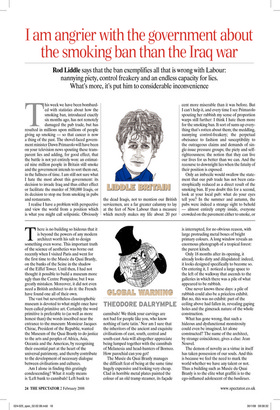T here is no building so hideous that it is beyond
the powers of any modern architect worth his salt to design something even worse. This important truth of the science of aesthetics was borne out recently when I visited Paris and went for the first time to the Musée du Quai Branly, on the banks of the Seine in the shadow of the Eiffel Tower. Until then, I had not thought it possible to build a museum more ugly than the Centre Pompidou; but I was greatly mistaken. Moreover, it did not even need a British architect to do it: the French have found one all of their own.
The vast but nevertheless claustrophobic museum is devoted to what might once have been called primitive art. Certainly the word primitive is preferable to (as well as more honest than) the words inscribed near the entrance to the museum: Monsieur Jacques Chirac, President of the Republic, wanted the Museum of the Quai Branly to do justice to the arts and peoples of Africa, Asia, Oceania and the Americas, by recognising their essential part at the heart of the universal patrimony, and thereby contribute to the development of necessary dialogue between civilisations and cultures.
Am I alone in finding this gratingly condescending? What it really means is ‘Left bank to cannibals! Left bank to cannibals! We think your carvings are not bad for people like you, who know nothing of tarte tatin.’ Nor am I sure that the inheritors of the ancient and exquisite civilisations of east, south, central and south-east Asia will altogether appreciate being lumped together with the cannibals of Melanesia and head-hunters of Borneo. How parochial can you get!
The Musée du Quai Branly manages the difficult feat of being at the same time hugely expensive and looking very cheap. Clad in horrible metal plates painted the colour of an old tramp steamer, its façade is interrupted, for no obvious reason, with large protruding metal boxes of bright primary colours. A long window reveals an enormous photograph of a tropical forest: the purest kitsch.
Only 18 months after its opening, it already looks dirty and dilapidated: indeed, it looks designed specifically to become so. On entering it, I noticed a large space to the left of the walkway that ascends to the galleries in which there was a pile of what appeared to be rubbish.
One never knows these days: a pile of rubbish could also be a priceless exhibit. But no, this was no exhibit: part of the ceiling above had fallen in, revealing gaping holes and the gimcrack nature of the whole construction.
What has gone wrong, that such a hideous and dysfunctional monstrosity could even be imagined, let alone constructed? The name of the architect, by strange coincidence, gives a clue: Jean Nouvel.
The demon of novelty as a virtue in itself has taken possession of our souls. And this is because we feel the need to mark the world whether we have any talent or not. Thus a building such as Musée du Quai Branly is to the elite what graffiti is to the ego-inflamed adolescent of the banlieues. to talk to their friends who smoked. As winter bit down, the crowds outside the pubs dispersed, but there were no greater numbers of people sitting at the tables inside. They were all at home, drinking and smoking, sticking large needles into effigies of Primarolo and the former health secretary Pat Hewitt.
The overpaid harridans at ASH bung out occasional press releases which are designed to be disingenuous: after the ban was introduced in Scotland, ASH did a survey which ‘revealed’ that ‘one quarter of Scots were more likely to visit pubs’ as a consequence. This is as meaningless a statistic as it’s possible to find. But because it would run counter to their agenda, neither the government nor ASH have bothered to collate the figures as to what has really happened to the pub trade. All the same, you can get a glimmering by reading the trade journals and scouring the local newspapers from around the country. In Oxfordshire one paper reported a drop of 50 per cent in pub sales, with several publicans announcing that they were going out of business, losing more than £1,000 per week. In Norfolk, by August — one month into the ban — two pubs announced they would be closing down as a result, with an estimated 40 per cent drop in trade. In Lewes, in East Sussex, the drop in trade was 25 per cent; in Bexhill 20 per cent. The publicans in Malton, in Yorkshire, announced that their livelihoods had been ‘devastated’ by the ban; in
wbad 1/23/08 849 A Pg 1
Huddersfield there were more reports of



































































 Previous page
Previous page